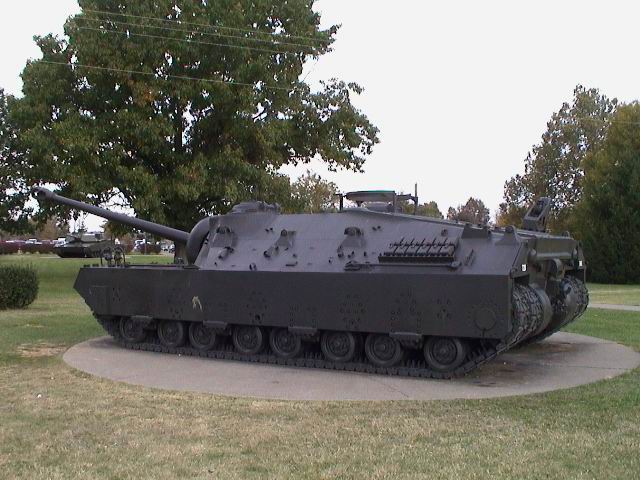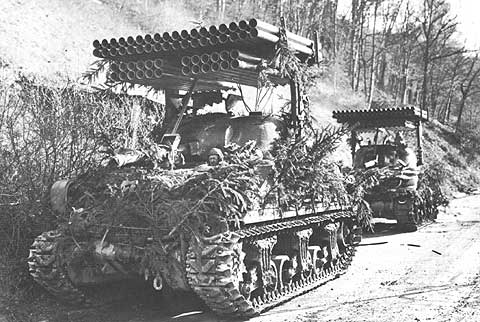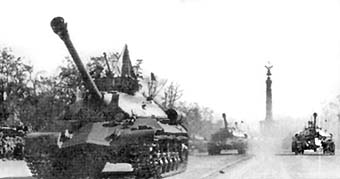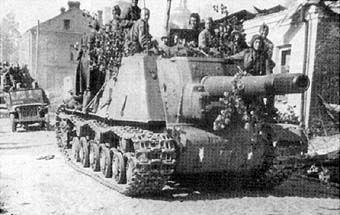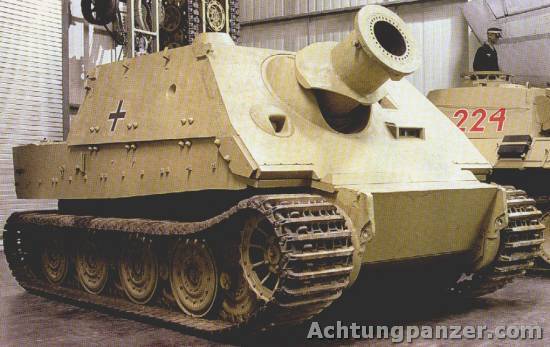American Super heavy tank T95/28 Gun motor carriage
The T28 "Superheavy Tank" is the heaviest armored vehicle ever produced by the United States, about 95 tons. Designed late in WW-II as an assault vehicle to penetrate fixed German defense positions such as the Siegfried Line, the T28 carries the thickest armor ever fitted to an armored vehicle, some of it well sloped. This is more like battleship armor than tank armor! The German's famed 88 mm would be nearly worthless against such a vehicle. The T28's turretless design saved a LOT of weight, which allowed much heavier armor to be fitted. Since the vehicle was designed for frontal assault, a full rotating turret was not needed. The gun did have limited traverse in the hull, allowing some freedom of target choice without turning the whole vehicle. The gun itself was a very-high velocity 'long' 105mm. Compared with even the 90mm in the T26 Pershings, this was a powerful weapon; and was sufficient to 'crack' most any target the T28 might encounter. While large, the T28 is smaller than a German 'Maus'. The Maus was designed as a real 'Tank', with full rotating turret, and heavy armor all around. The price it paid for this was an astonishing weight of about 180 tons, with corresponding lack of mobility, transport problems, and overloaded drive components! The T28, on the other hand, was a special purpose vehicle, with much heavier armor (admittedly only on the front and sides), yet far less overall weight. As an assault vehicle, the T28 was formidable. Low and squat, it presented very little target, and what did show was almost impenetrable. Only plunging artillery fire and anti-tank mines would much have bothered it. True, the T28 was slow, but this was not overly important for it's designed purpose. Alone, in open country, the T28 could be easily avoided or outflanked, but it was not envisioned to use in such a situation.
Dimensions: 11.12 x 4.55 x 2.85 (h) mt
Weight: 85.5 tons
Armament: 1x 105mm high velocity gun, 1 x .50 Browning MG
Propulsion: Gasoline Ford GAF, 410 hp
Speed (max): 12.8 km/hr
Armor (max): 300 mm
Crew: 8
American Multi barrel rocket launcher T34 Calliope
The Calliope consisted of a 60 tube 116.84mm rocket projector mounted on a frame above the tank turret. It could be jettisoned if necessary. While mainly seen fitted to the M4A1 it was seen on other models of the M4.
Dimensions: 6.16 x 2.67 x 2.79 (h) mt
Weight: 30.7 tons
Armament: 1x 75mm L3 gun, 60x 114.3 mm rockets
Propulsion: Gasoline Chrysler A-57, 425 hp
Speed (max): 40 km/hr
Armor (max): 75 mm
Crew: 3
British Super heavy tank A39 Tortoise
In early 1943 considerable thought was being applied to the preparation of men and equipment for the assault of the German forces in north-west Europe. Clearly tough resistance was to be expected with the enemy fighting from strongly fortified positions. It is against this background that a new class of vehicles, Assault Tanks emerged. The concept behind these vehicles was for maximum armour protection at the expense of mobility. Initially work was concentrated on the A33 essentially a heavy Cromwell (cruiser) and the A38 Valiant which may be regarded as a heavy Valentine (infantry tank). In addition to this there was a program to up armour the Churchill. This was pretty typical of WWII British tank development as the adopted doctrine of Infantry tanks and Cruisers invariable meant that each new design specification could be approached from two existing starting points. Designed specifically to outgun and outlast the heavy German tanks and self propelled guns. At the time of design, the armor was totally proof against all known German guns. The design work began in 1944 but the first of 6 test vehicles were not delivered until 1947. The tank was never put into production.
Dimensions: 9.9 x 3.63 x 3 (h) mt
Weight: 77 tons
Armament: 1x 32pdrBall-mounted concentric recoil Tk Mk I , 3x 7.92mm Besa MG
Propulsion: Gasoline Rolls-Royce Meteor V, 600 hp
Speed (max): 19.2 km/hr
Armor (max): 279 mm
Crew: 7
British Radio tank A27m Cruiser MkVIII Cromwell, Command/OP
Perhaps the most important British tank at the time of the invasion of Europe in 1944. The engine was placed between 2 air cleaners and 2 fuel tanks. The radiators were mounted upright in the back. In later models side doors were added for the driver and hull gunner to be able to exit the tank easier. Some storage was lost, and local modifications often added additional storage. With experience in Africa, the General Staff change the specifications to include the 75 mm gun that would allow HE ammunition to be fired at infantry and anti-tank targets. The ammunition was American made and taken from the Lend Lease supplies. This was the most numerous British tank in 1944-45, and replaced Shermans in many units. Many considered it too lightly armed and armored. Many were used by the 7th Armored. Vehicles in the later part of the series were constructed using 100% welding. The Cromwell continued in service long after WW2 ended. Cromwell 2 had it's hull mounted MG removed for more internal storage. Cromwell 2 also had wider tracks installed. Cromwell 5w was the first all welded model and was fitted with a 75mm main gun. Cromwell O.P. was the command version. The O.P. had a dummy gun and extra radio equipment.
Dimensions: 6.03 x 2.9 x 2.46 (h) mt
Weight: 28 tons
Armament: 1x 95mm short howitzer, 2x MG
Propulsion: Gasoline Rolls-Royce Meteor V, 600 hp
Speed (max): 64 km/hr
Armor (max): 76 mm
Crew: 5
Russian Heavy Tank IS-3
In October 1944, the first prototype named "Object 703" was shown to G.K. Zhukov and A.M. Vasilevsky. They reported to Stalin about the new tank and Stalin signed an order to accept the new tank for service.
After those trials, the "Object 703" was shown to G.K. Zhukov and A.M. Vasilevsky. They reported to Stalin about the new tank and Stalin signed an order to accept the new tank in service. The IS-3 heavy tank (or its working "Object 703" designation) as approved, boasted a very good hull and turret, with excellent armor protection. The sloped armor on the turret and hull allowed better overall protection of the tank. The rear armor plate was sloped rearwards. The centered driver's position was fitted with a sight-equipped hatch. Before opening the hatch, the sight had to be removed.
The semi-automatic 122 mm main gun was fitted with a muzzle brake. The rate of fire was about two to three shots per minute. Like its predecessor, the IS-2, the IS-3 normally carried 28 shells: eighteen high-explosive fragmentation rounds, and ten armor-piercing rounds. This ammunition distribution suggests that infantry and other 'soft' targets were intended as the main targets for the IS-3. The IS-3 carried four internal steel fuel tanks with a total capacity of 450 litres. The fuel tanks sat in pairs on both sides of the engine. Furthermore, the IS-3 was equipped with four cylindrical external fuel tanks. These external fuel tanks each carried 90 litres, and were connected to the internal fuel tanks. The external fuel tanks were equipped with emergency release brackets in case of a fire or a sudden attack. The first test group of IS-3's left the factory gates in mid-May 1945. Despite western opinion (usually I hear about IS-3's seen on the streets of Vienna), IS-3 tanks weren't involved in battles on the Eastern Front. The participation of IS-3's in Far Eastern Front battles (in August 1945) is still unverified: at least one tank regiment of IS-3 tanks was sent, but Soviet combat records don't confirm any actual combat. On September 7, 1945, a united Allied military parade was held in Berlin. The parade began with infantry columns: Soviet soldiers of the 9th Rifle Corps of the 5th Shock Army, then soldiers of the French 2nd Infantry Division, Alpine troops, and Zoaves. There was a brilliant display by the British 131st Infantry Brigade. Paratroopers of the 82nd Airborne Division brought up the rear. After a short break, a continuous mechanized column started.
Dimensions: 6.67 x 3.20 x 3.43 (h) mt
Weight: 45.8 tons
Armament: 1x 122mm D-25S L/45 Cannon, 2x 7.62 mm DT MG, 1x 12.7 mm DSchK 38/43 AA
Propulsion: Diesel V-2-k, 600 hp
Speed (max): 40 km/hr
Armor (max): 200 mm
Crew: 4
Russian Self propelled gun ISU-152
The ISU-152 was one of the first Soviet heavy self- propelled artillery carriages. Initially, it was based on the KV-1 chassis. When production of KV-1 ceased, the IS Series chassis was used. Entered service in 1943 in time for the battle of Kursk. Served both as an anti-tank gun and a heavy assault gun. Fired a 2-piece cartridge at a rate of only 2 shots/min. Ammunition storage was sparse, requiring supplies by ammunition carriers. Called "Zveroby" (animal killer) by Soviet tank crews because of the devastating effect of its 95 Ib. projectile on Panthers, Tigers and Elephants. Very effective in the Battle of Berlin. Served after the war as late as 1956 where it was used in crushing the Hungarian uprising. Over 700 were produced. Developed into the ISU-130 post war with a 130mm gun
Dimensions: 9.18 x 3.07 x 2.48 (h) mt
Weight: 46 tons
Armament: 1x 152mm howitzer ML20, 1x 12.7mm MG
Propulsion: Diesel V-2-k, 520 hp
Speed (max): 37 km/hr
Armor (max): 90 mm
Crew: 5
German Structure destroyer Sturmtiger
During World War II, Germany produced a variety of specialized armored fight-ing vehicles, including Sturmpanzers-assault tanks. They were to be used as heavy infantry support vehicles in urban street warfare against buildings and in operations against heavily fortified defenses. In the autumn of 1942, under the influence of heavy fighting in Stalingrad, the concept of a heavy infantry support vehicle designed for street fighting was revived. At the time, the only vehicle that fulfilled the role was the Sturminfanteriegeschütz 33, while Sturmpanzer IV Brummbär was still under development. The Sturmtiger was originally to be armed with a 210mm howitzer, but it was not available at the time. On August 5th, 1943, it was decided to mount a modified Tiger I heavy tank with a 380mm rocket launcher/mortar installed in a new superstructure. The new vehicle received the designation of 38cm RW61 auf Sturm(panzer)mörser Tiger, but it was also known as Sturmtiger, Sturmpanzer VI and Tiger-Mörser. The Sturmtiger was armed with a short-barreled 38cm Raketenwerfer 61 L/5.4, breech-loading rocket launcher/mortar. The RW 61 launcher fired short-range (4,600 to 6,000 meters, or 2,850 to 3,720 yards) high-explosive rocket-propelled projectiles. The launcher was fitted with a PaK Zielfernrohr 3 x 8 telescopic sight. Each projec-tile was almost 1.5m (five feet) long and weighed 345 to 351kg (759 to 772 pounds). Two types of ammunition were available-high-explosive Raketen Sprenggranate 4581 (with a 125kg, explosive charge) and shaped-charge Raketen Hohladungsgranate 4582 for use against fortifications. The shaped-charge round could penetrate up 2.5m (8 feet) of reinforced concrete. The Sturmtiger main armament was originally developed by Rheinmetall-Borsig in Dusseldorf from an anti-submarine depth charge launcher developed for the Kriegsmarine. Sturmtiger could demolish any building or other target with a single shot, but it could carry only 14 rocket projectiles inside the superstructure. Only 18 Sturmtigers were produced, and they did not have any effect on the out-come of the war. In their limited use, Sturmtigers proved to be excellent defensive weapons but were slow and mechanically unreliable, and most were abandoned or destroyed by their crews after mechanical breakdown or because of fuel shortage. Their heavy armor protection forced the enemy to destroy them with heavy artillery bombardment or air attack. In January 1945, a single round from a PzStuMrKp 1001 Sturmtiger reportedly destroyed three American M-4 Sherman tanks located in a targeted village.
Dimensions: 6.28 x 3.70 x 3.46 (h) mt
Weight: 65 tons
Armament: 1x 380mm Stu M RW61 L/5.4 rocket launcher, 7.92mm MG34
Propulsion: Diesel Maybach HL 230 P 45, 700 hp
Speed (max): 40 km/hr
Armor (max): 150mm
Crew: 5
German Heavy mortar 60 cm Mörser Gerät 040
The self-propelled version of the 60cm siege mortar was ordered in June 1937. General Karl Becker of the Artillery was involved in the development, hence the name Karl was used to describe the gun. The driving trials were held at Unterlüss in May 1940. Delivery of the six production vehicles took place from November 1940 to August 1941. In February 1941, discussions commenced. concerning increasing the range of the weapon, and in May 1942, 54cm barrels ( Gerät 041 ) were ordered for the six vehicles. At a conference with Hitler in March 1943, it was stated that the first 54cm Gerät 041 would be delivered by June 1943, and the third, by mid-August. The 60cm and 54cm barrels appear to have been interchanged as required. In 1945, US forces captured vehicle II with a 60cm, and vehicle V with a 54cm. The prototype chassis, built in 1939, had eight road wheels with external swing arms. production Karl had eleven road wheels. Ammunition was transported in a tracked Munitionsschlepper converted from the PzKpfw IV, four rounds in each Schlepper. For the 60cm 040, the s Be Granate weighed 2.117 tons and the Ie Be Granate, 1.70 tons; in this case of the 54cm Gerät 041, 1.58 tons and 1.25 tons respectively. Maximum rate of the fire was 6 rph ( rounds per hour ).
Dimensions: 11.15 x 3.16 x 4.78 (h) mt
Weight: 123 tons
Armament: 1x 600mm schwere Betongranate 040 mortar
Propulsion: Diesel Daimler Benz MB 503, 580 hp
Speed (max): 10 km/hr
Armor (max): unknown
Crew: 11
Italian Wheeled assault gun Cannone semovente Breda 501 "Studio 102"
Considered "the mother of all the autocannoni", a formidable challenger if Ariete and Centauro divisions could have it, most of allied tanks in north africa were destroyed just by autocannoni. Little is known about this vehicle built by Breda. The unused wheeled desing allowed it to travel at higher speed and guaranteed more agility in the battlefield. Breda began to study an armoured autocannone at the beginning of 1942. It seems that Breda try to collaborate with Ansaldo, but this attempt was unsuccessfull (Ansaldo was trying to build an autocannone on the SPA Dovunque 41 chassis). The prototype was read for tests on the end of July 1943. Test began soon after. The armistice prevented any order, so it was never built. The "autotelaio tubolare speciale Breda" was a new 6x6 chassis expressely studied by Breda for an autocannone. It had 6 wheel drive: the forward axis (with steering drive) had "single" pneumatic wheels "9,75x24 artiglio", while the other two had "double" wheels.
It could mount also "double" forward wheels (the change could be done in the field using the 2 reserve wheels). The engine was collocated in the rear. The gun was aimed by two artillerymen sitting aside and rotanting with the gun. They could fire with a lever control. They and the other artillerymen were protected by a shield. The "ginocchiello" was high 2050 mm from the ground and allowed a maximum elevation of 23 degrees, and an azimuthal rotation of 180 degrees (90 left and 90 right). For rotations of less then 30 degrees left and 30 rightit could fire without rotating the flanks of the superstructure. For higher angles flanks could be rotated by 90 degrees (thus they were horizontal, allowing more room for the artillerymen) or of 180 degrees if needed.
Dimensions: 6.615 x 2.436 x 1.83 (h) mt
Weight: unknown
Armament: 1x 90/53mm AT cannon, 2x 8mm Breda SAFAT AA MG
Propulsion: Diesel SPA, 142 hp
Speed (max): unknown
Armor (max): 30mm
Crew: 3
Italian Self propelled artillery Semovente da 149/40
The Italian Army was not far behind the Germans in realizing the need for assault guns and developed a string of vehicles that outwardly resembled the StuG III. These Italian assault guns were produced in appreciable numbers for they were better armored and quicker to produce than the contemporary Italian tanks. But by the time significant numbers had been issued, Italy was effectively out of the war, and most of these guns fell into German hands. The majority of these semovente were armed with 75mm and 105mm guns and howitzers, but were mostly direct fire weapons. The Italian artillery arm still needed self-propelled artillery weapons to support the armored formations. Ansaldo therefore diverted some of its development facilities to design a powerful artillery weapon that could be carried on a trucked chassis. In the end, Ansaldo settled on an existing weapon, the Canone da 149/40 modello 35 and placed it on a much modified Carro Armato M15/42 tank chassis. The selection of these two pieces of equipment was made in order to produce as good a carriage/weapon combination as possible. The snag however was that the Italian army was already crying out for large numbers of both the gun and tank and Italian industry could not keep up with the demand. This new weapon, the Semovente da 149/40 got off to a shaky start. The Semovente da 149/40 was a completely unprotected weapon as the long gun barrel was placed on an open mounting carried on the turretless tank chassis. The gun crew stood in the open to serve the gun that had is trunnions mounted right to the rear to absorb some of the recoil forces produced on firing. It was late 1942 before the first prototype was ready for prolonged firing trials, but even before these were over unsuccessful attempts were being made to start production. Before the lines could start rolling the Italians surrendered to the Allies and the Germans took over what was left of the Italian economy. Thus the Semovente da 149/40 prototype remained the sole example of what seemed to be a promising design. The Canone da 149/40 modello 35 could fire a 46kg shell to a range of 23700m, at which distance the lack of protection for the gun crew would have been of relatively little importance.
Dimensions: 6.60 x 3 x 2 (h) mt
Weight: 24 tons
Armament: 1x 149mm 149/40 modello 35 canon
Propulsion: Gasoline SPA engine, 250 hp
Speed (max): 40 km/hr
Armor (max): 25mm
Crew: 2
Japanese Super heavy tank O-I
Heavy armored and heavy armed tank. It is said that one prototype was being manufactured when WWII ended. However, according to an engineer concerned with it, it had been completed and was disassembled for dispatching to Manchuria. No photo nor drawing of O-I is known. The O-I had three-turrets and weighed 120 tons. Its dimensions were 10 meters by 4.2 meters by 4 meters high. The armor was 200mm (MAX). The tank had a top speed of 25km/hr. This version a two gasoline engines developing 550 PS/1500 rpm. The O-I had 1 x 105mm Cannon, 1 x Type 1 37mm (in a forward mounted sub turret), and 3 x Type 97 7.7mm (one mounted in a forward sub turret) where as the Experimental version also mounted a Type 1 37mm in a rear facing sub turret.
Dimensions: 10 x 4.2 x 4 (h) mt
Weight: 120 tons
Armament: 1 x 105mm Cannon, 1 x Type 1 37mm (in a forward mounted sub turret), 3 x Type 97 7.7mm (one mounted in a forward sub turret), 1x Type 1 37mm in a rear facing sub turret
Propulsion: 2x Gasoline engines, 550 hp each
Speed (max): 25 km/hr
Armor (max): 200mm
Crew: 11
Japanese Armored Engineer Vehicle Soukou Sagyou Ki "SS-Ki"
SS had following nine functions; (1)destruction of pillbox, (2) digging trench, (3)mine sweep, (4)destruction of wire entanglements, (5)disinfection, (6)scattering poison, (7)flamethrow, (8)crane, (9)smoke discharge, and a bridgelaying function was added later. On the upper photo, two stick-like projections in front of the vehicle and in the side of vehicle are flamethrowers. The wheels on the top of the hull are the device for loading a bridge.At first, SS was developed in order to destroy the Soviet pillbox in the border of Manchuria. However, during its development, many functions were added by the request of users. SS could achieved many functions by replacing the devices. Though SS had a lot of functions, most of them were insufficent and the really useful one was a bridgelayer only. First four SS were deployed in the 1st Independant Mixed Brigade and they executed the flamethrow in the battle near Peking on July 28th, 1937. It was the first time that SS saw the action. After that, SS was deployed in the special engineer regiment for SS, which was established for the service of the destruction of the Soviet pillbox. When the tank divisions were established, the engineer regiment for SS was taken over to the tank divisions. In tank divisions, SS was mainly used as a bridgelayer. When the 2nd Tank Division went to the Philippines in the last WWII, some SS were also sent there. The action of SS in the Philippines is not known, but eight SS were captured by Americans.
Dimensions: 4.865 x 2.52 x 2.088 (h) mt
Weight: 13 tons
Armament: 3x Flamethrowers, 1x Machine Gun
Propulsion: Diesel Engine, 145 hp
Speed (max): 37 km/hr
Armor (max): 25 mm
Crew: 5
Sweet! but the tank you have pictured is actualy a modification on the original O-I design.




 This topic is locked
This topic is locked